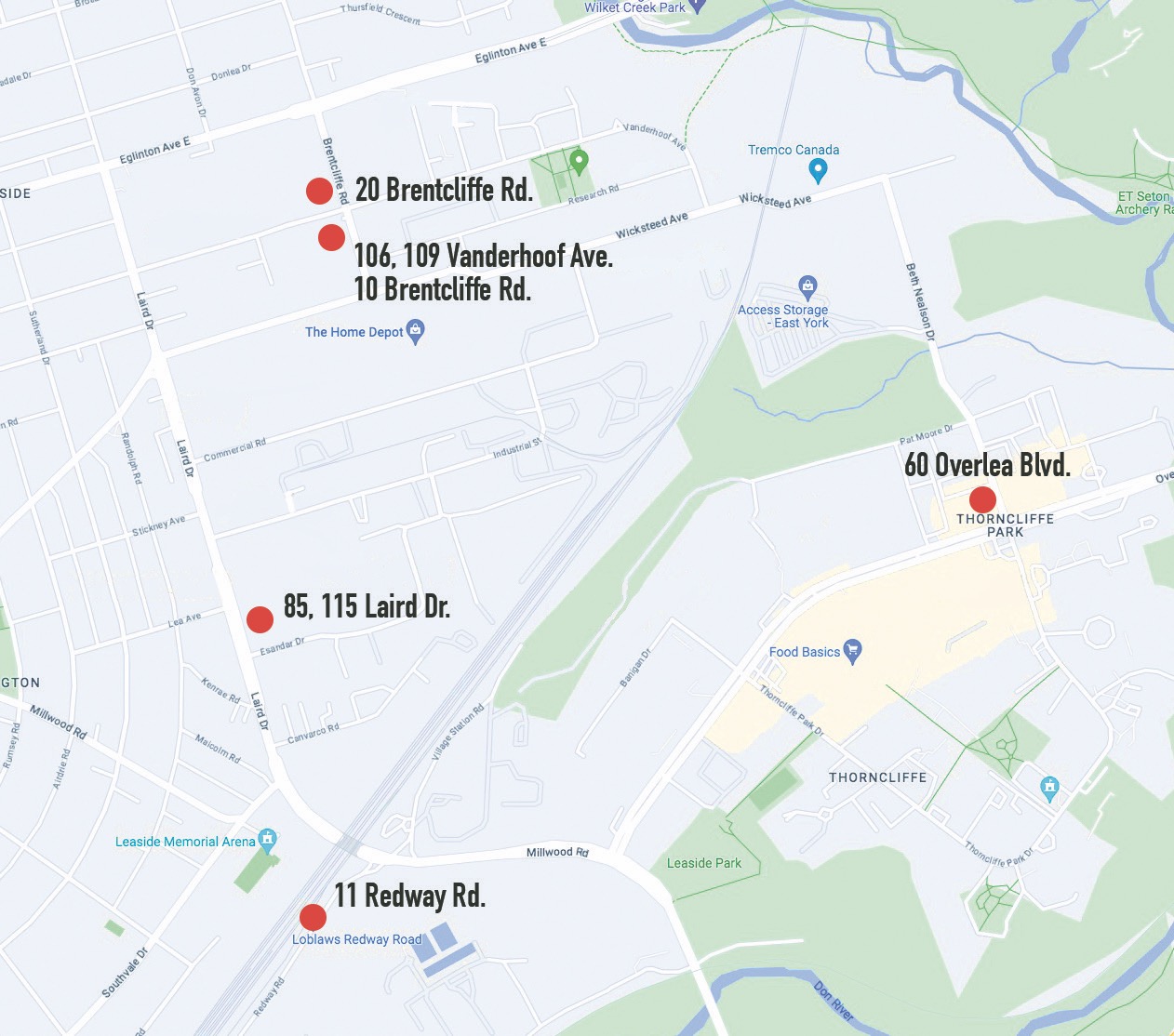
Today we hear a lot about the need for housing, but what about jobs? Leaside was designed by Frederick Gage Todd, Montreal town planner and landscape architect, with jobs and housing in close proximity: lands designated residential west of Laird, and industrial east of Laird. The juxtaposition of business park and residential communities has been of great public benefit. Even today, skilled jobs that are close to home reduce the need to commute and use private vehicles pumping out CO2.
True, that over time, “industrial” has been watered down to “commercial and industrial,” and the area south of Eglinton from Laird over to the Don Valley has emerged as a mixed residential and commercial area (“Leaside East”) whose residential conversion began with townhouses (Hyde Park), and mid-rise (Scenic apartments) and is planned to fill in with high-rise developments from Laird to Aerodrome, east of Brentcliffe. However, the southern boundary of residential development is established as Vanderhoof Avenue: “thus saith the Ontario Municipal Board” in a landmark 2001 decision.
The pressure to convert industrial lands to residential is unrelenting, representing a potential financial bonanza for the speculating land owner, but equally a loss of jobs and economic activity in the Employment Area. Paul Scrivener of the Toronto Industrial Network wrote in his submission to City Council that “approval of land conversion represents death of a thousand cuts to an Employment Area.”
The City of Toronto has a formal process, called Municipal Comprehensive Review (MCR), to consider requests for Employment Area conversions (mostly to Mixed Use, which permits residential) that are reviewed by staff, and approved or denied by City Council. The most recent MCR wound up at City Council in July of this year, with 45 Employment Area conversion requests City-wide, of which five of the 45 involved lands are within or adjacent to the Leaside Business Park:
- 60 Overlea Blvd. (Salvation Army Thrift Store)
- 85 and 115 Laird Dr. (Leaside Village Shopping Centre)
- 20 Brentcliffe Rd. (the southern (rear) portion of 939 Eglinton Ave. East
- 106, 109 Vanderhoof Avenue, and 10 Brentcliffe Rd.
- 11 Redway Rd. (Loblaws Store)
Of the five Leaside requests, following staff advice, City Council refused four, and one (20 Brentcliffe Rd.) was approved. In so doing, City Council maintained its support for two benchmark principles of Leaside planning:
- In refusing conversion requests for 106, 109 Vanderhoof Ave. and 10 Brentcliffe Rd. (which are south of Vanderhoof) but approving 20 Brentcliffe Rd. (north of Vanderhoof), City Council confirmed Vanderhoof Avenue as the southern boundary of residential development on formerly industrial lands south of Eglinton Avenue and east of Laird Drive.
- In refusing conversion requests for 85 and 115 Laird Dr., Council confirmed Laird Drive as the historic boundary between the Residential (west) and Industrial areas (east) as defined in the Leaside Model Garden Town Plan designed by Frederick Gage Todd in 1912.
And in refusing conversion of the Overlea Boulevard properties Council avoided pre-judging any future planning processes to be established to consider development impacts of the Ontario Line.
So, is the Leaside Business Park protected? Not necessarily. The province is making changes that put the City Council decisions at risk.
Up to now the Business Park has been protected through Official Plan policies and zoning bylaws, as well as Ontario Municipal Board decisions respecting the Employment Lands boundaries and policies therein. However, a recent provincial proposal released in April (formal public comment ended in August) to consolidate two major planning documents – A Place to Grow: Growth Plan for the Greater Golden Horseshoe (Growth Plan), 2020, and the Provincial Policy Statement, 2020 – appears to endanger this long-standing policy framework.
The proposed Provincial Planning Statement is intended to form the basis for the province to achieve its housing objectives. Unfortunately, the document fails to set a foundation to achieve the province’s vision of a complete community providing employment, community services, and all housing types to meet the current and future needs of Ontarians:
- Municipal Comprehensive Reviews would no longer be required, creating open season on employment conversions, creating uncertainty for employers, and reducing future opportunities for Ontario businesses to grow within their markets.
- Definitions of Employment Areas would be changed. The Provincial Planning Statement is recommending the removal of office, institutional and film production industries from Employment Areas. This appears short-sighted and may have negative consequences for those businesses and for Ontario as a business location.
What can we do? We can wait for the next election, but we can also write to Steve Clark, Minister of Municipal Affairs and Housing, to express our concerns.


